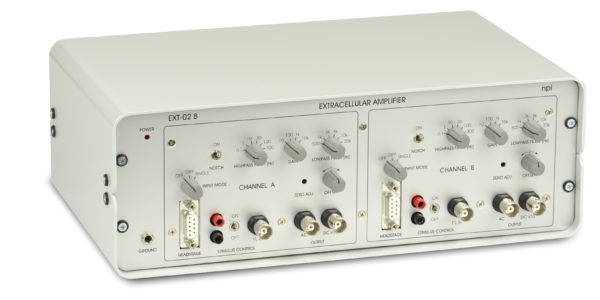
Available headstages:
In extracellular recording usually very small potentials in the µV range are measured. This requires high amplification and often also filtering.
npi’s range of extracellular amplifiers meet these requirements. They are available as desktop instruments, in a 19” rackmount cabinet or as module for the EPMS modular system. All npi extracellular amplifiers have high pass and low pass filter and gain up to 10000. They allow DC measurements and AC recordings in which offsets are cancelled automatically. Audio monitors and electrode resistance meters are available as well. The use of external power supplies and high quality electronics ensure low-noise recording of small signals.
Models include:
Most systems are equipped with a small headstage with high impedance differential inputs to suppress noise and other distortions.
Visone, R., Lozano-Juan, F., Marzorati, S., Rivolta, M. W., Pesenti, E., Redaelli, A., Sassi, R., Rasponi, M., & Occhetta, P. (2023). Predicting human cardiac QT alterations and pro-arrhythmic effects of compounds with a 3D beating heart-on-chip platform. Toxicological Sciences : An Official Journal of the Society of Toxicology, 191(1), 47–60. https://doi.org/10.1093/toxsci/kfac108
Guneykaya, D., Ugursu, B., Logiacco, F., Popp, O., Feiks, M. A., Meyer, N., Wendt, S., Semtner, M., Cherif, F., Gauthier, C., Madore, C., Yin, Z., Çınar, Ö., Arslan, T., Gerevich, Z., Mertins, P., Butovsky, O., Kettenmann, H., & Wolf, S. A. (2023). Sex-specific microglia state in the Neuroligin-4 knock-out mouse model of autism spectrum disorder. Brain, Behavior, and Immunity, 111, 61–75. https://doi.org/10.1016/j.bbi.2023.03.023
Timmermann, A., Tascio, D., Jabs, R., Boehlen, A., Domingos, C., Skubal, M., Huang, W., Kirchhoff, F., Henneberger, C., Bilkei-Gorzo, A., Seifert, G., & Steinhäuser, C. (2023). Dysfunction of NG2 glial cells affects neuronal plasticity and behavior. GLIA. https://doi.org/10.1002/glia.24352
Ferrari, E., Visone, R., Monti, E., Torretta, E., Moretti, M., Occhetta, P., & Rasponi, M. (2023). LivHeart: A Multi Organ-on-Chip Platform to Study Off-Target Cardiotoxicity of Drugs Upon Liver Metabolism. Advanced Materials Technologies. https://doi.org/10.1002/admt.202201435
Confettura, A. D., Cuboni, E., Ammar, M. R., Jia, S., Gomes, G. M., Yuanxiang, P. A., Raman, R., Li, T., Grochowska, K. M., Ahrends, R., Karpova, A., Dityatev, A., & Kreutz, M. R. (2022). Neddylation-dependent protein degradation is a nexus between synaptic insulin resistance, neuroinflammation and Alzheimer’s disease. Translational Neurodegeneration, 11(1). https://doi.org/10.1186/s40035-021-00277-8
Muhia, M., YuanXiang, P. A., Sedlacik, J., Schwarz, J. R., Heisler, F. F., Gromova, K. V., Thies, E., Breiden, P., Pechmann, Y., Kreutz, M. R., & Kneussel, M. (2022). Muskelin regulates actin-dependent synaptic changes and intrinsic brain activity relevant to behavioral and cognitive processes. Communications Biology, 5(1). https://doi.org/10.1038/s42003-022-03446-1
|
Input (headstage) |
>10-12 W, range ±1 V |
|
Differential Input |
CMR >90 dB at 1 kHz (tested with 0 W input resistance) |
|
Input Capacitance |
30 pF |
|
OFFSET compensation |
set by potentiometer, range: ±1 V |
|
HIGHPASS Filter |
single pole, attenuation: -6 dB / octave, |
|
LOWPASS Filter |
single pole, attenuation: -6 dB/octave, |
|
GAIN |
rotary-switch 10-100-1k-10k |
|
Output |
range: ±10 V into 1 kW / ±1 V into 50 W |
|
Power Supply |
18V, AC, min. 1.5 A |
|
Dimensions |
305 x 180 x 105 mm³ (W x D x H) |
|
Headstage |
|
|
Input (headstage) |
>1012 W, range ±1 V |
|
Headstage Size |
70 x 26 x 26 mm3 |
|
Holding Bar |
length: 150 mm; diameter: 8 mm |
In extracellular recording usually very small potentials in the µV range are measured. This requires high amplification and often also filtering. npi’s range of extracellular amplifiers meet these requirements.
